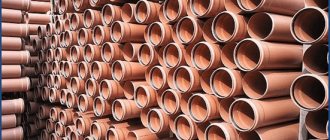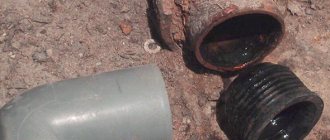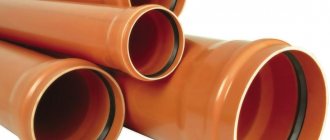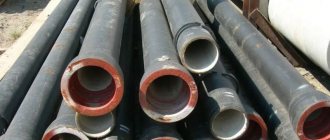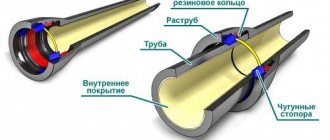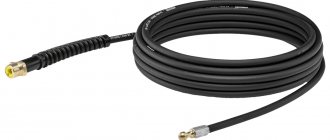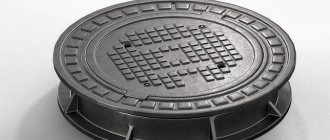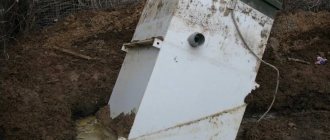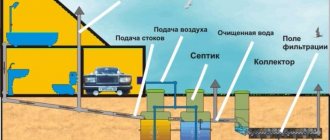Corrugated pipes for external sewerage
When describing the types of sewer pipes, we will separately mention special corrugated versions for outdoor use.
By design, corrugated pipes are divided into:
- single-layer;
- two-layer.
Single-layer pipes are corrugated both outside and inside.
Single-layer corrugated pipe.
The two-layer version has an internal smooth channel through which drains flow, and an outer skin with an air gap. The pipe ribs protect the communication from mechanical stress and contribute to increased strength.
Double layer pipe.
Corrugated pipes are classified according to load resistance:
- For light loads. They are light in weight, very flexible and easy to lay in difficult areas. Suitable for external drainage systems.
- For medium loads. The pipes have average resistance to mechanical loads and can be laid underground.
- For extra heavy loads. Corrugated pipes with thick walls that can be laid under highways and in industrial areas.
To organize a sewage system in a domestic environment, light and medium category pipes are most often used. They are resistant to standard loads for such places from pedestrians, equipment and ground movements, and also retain these characteristics throughout their entire service life.
The connection of corrugated pipes is carried out with a special fitting. The diameter of the pipes ranges from 100 to 1200 mm, depending on the need for sewer throughput.
Types of sewer pipes
Once upon a time, dark times reigned on our planet. And there was no end in sight. But with the development of the sewer system, everything changed. This happened in Ancient Rome before the start of the new chronology. And already in the 20th century AD, this drainage system began to be installed everywhere in all developed cities of the world. Therefore, now a person is so accustomed to this convenience that, no matter what, in the event of repairs or construction, he is ready to endure and overcome all the difficulties associated with installing a sewer system in his apartment or house.
And there really are enough problems. After all, it is necessary to select the required diameter of pipes, count their number, install a sewer system, and, of course, choose the material from which the pipes are made. This last question is what this article aims to answer. Since such important indicators for us as price and service life depend on the type of material.
Today, the following types of sewer pipes are widespread:
- steel;
- cast iron;
- ceramic;
- asbestos-cement;
- plastic - PVC and polypropylene polyethylene;
- metal-plastic.
Let us turn to each of these types of products separately and determine their main characteristics.
Steel pipes
Pipes made from steel are most often used in the construction of water supply and heating systems. But they try not to use them for sewerage, since the material is highly susceptible to corrosion. If you choose this type of pipe, experts recommend covering them with bitumen or buying galvanized ones if possible.
Steel pipes have a wide range of diameters and can be produced either welded or seamless. The latter, in turn, are more durable and reliable, but also more expensive than the former.
Table of main characteristics of steel pipes
| Index | Meaning | Note |
| Price | from 100 rub./p.m. | The cost of a steel tube with a diameter of 100 mm for Central Russia for the period 2015 |
| Life time | 10-25 years | The service life depends on the grade of steel, the wall thickness and the quality of the anti-corrosion coating. A few words about corrosion. So, on average for steel it is 0.1 mm per year. |
| Installation methods | welding, thread, couplings, flanges | Connecting steel pipes can be done using any currently available method. But still, the most common are welding and threading. |
| Protection | anti-corrosion | Steel is susceptible to rotting, so pipes for external sewage systems must be treated with waterproof compounds, for example, coated with bitumen. To install sewer lines indoors, painting them is sufficient. |
| Weight 1 linear meters | about 8 kg | Weight is indicated for pipe ø102x4 |
| Available diameters | 10-1 420 mm | In the case of a sewer system for a residential building, you can easily select the required diameter on the construction market |
| Maximum temperature | 800°C and 60°C | The steel pipes themselves easily withstand household temperatures. But the protection can soften under the influence of lower temperatures. For example, for bitumen it is set at 60°C. Therefore, if you want your pipes to last a long time, then choose anti-corrosion protection in accordance with the temperature conditions of operation. |
| Frequency of blockage formation | often | In steel pipes, more often than in others, it is necessary to break through the resulting blockage. This usually happens due to a decrease in the diameter of the pipe due to corrosion. |
| Strength | excellent | Steel pipes have excellent strength under both high and low temperatures. But upon impact, dents can form on them, which, if significant, will lead to rapid clogging of the pipes. |
Cast iron pipes
Currently, it is the cast iron pipes that were buried back in Soviet times that management companies are trying so hard to replace. Thanks to this, residential yards often look like a war zone - trenches, artificial hills, heavy equipment and people in special clothing, ready to perform a feat, but not today.
Cast iron pipes were used in the USSR for two simple reasons - long service life and low price.
Table of main characteristics of cast iron pipes
| Index | Meaning | Note |
| Price | from 120 rub./p.m. | cost of a cast iron tube with an internal diameter of 100 mm for Central Russia for the period 2015 |
| Life time | 50-100 years | The service life of cast iron pipes depends on the quality of cast iron and the composition of the anti-corrosion protection |
| Installation methods | through a socket or coupling | Cast iron pipes are produced both with a socket (widening at the end of the pipe) and without it. In the first case, one pipe is inserted into another, and the connection is sealed with a rubber gasket and lubricated with a water-insoluble lubricant. In the second case, pipes of the same diameter are connected to each other at the end using a coupling, which has a clamp for tightening. It is also worth noting here that cast iron pipes are leaders in installation complexity. |
| Protection | anti-corrosion | These pipes, just like steel ones, require anti-corrosion treatment - painting, coating with bitumen, etc. If they are produced in accordance with GOST 6942-98, then a layer of bitumen must already be applied to their inner and outer sides. |
| Weight 1 linear meters | about 13 kg | Weight is indicated for a pipe with an internal diameter of 100 mm and a wall thickness of 4.5 mm |
| Available diameters | 50-1,000 mm | The easiest way to find diameters of cast iron pipes is 50, 100 and 150 mm, since they are produced according to GOST 6942-98. As for large diameters, they are produced in accordance with GOST 9583-75. Also, according to the latest standard, it is advisable to purchase pipes if pressure sewerage with a high design pressure is planned. |
| Maximum temperature | 400°C and 60°C | Such pipes are quite suitable for domestic needs. |
| Frequency of blockage formation | less often than in steel pipes | Thanks to the internal waterproofing, large particles entering the pipe will pass through much better than in steel pipes. It also delays the period when the product begins to decrease in diameter due to corrosion. |
| Strength | good | Cast iron pipes can withstand significant mechanical stress. But in cases where the tensile strength is exceeded, the product does not bend, but breaks. |
Ceramic pipes
Ceramic pipes are very similar in properties to cast iron pipes. But unlike the latter, ceramic pipes do not rot. In other words, they are 100% resistant to corrosion, as well as acids and alkalis.
In everyday life, such pipes are used quite rarely due to their high cost. Therefore, if it was decided to use this particular type of pipes, then know that they are laid when installing non-pressure industrial and domestic sewer networks.
Table of main characteristics of ceramic pipes
| Index | Meaning | Note |
| Price | from 800 rub./p.m. | cost of a ceramic tube with a diameter of 150 mm for Central Russia for the period 2015 |
| Life time | 50-150 years | It all depends on the external operating conditions and the moles’ attitude towards them |
| Installation methods | through the bell | Ceramic pipes in 99% of cases are connected to each other through a socket using seals |
| Protection | not required | These products are resistant to aggressive environments, water and fire without any additional protection |
| Weight 1 linear meters | about 8 kg | Weight is indicated for a pipe with an internal diameter of 150 mm and a wall thickness of 19 mm |
| Available diameters | 150-600 mm | In accordance with GOST 286-82, the internal diameter of pipes starts from 150 mm and ends at 600 mm. The minimum wall thickness is 19 mm. |
| Maximum temperature | more than 1,000°С | Such pipes are quite suitable for domestic needs. |
| Frequency of blockage formation | less often than in cast iron pipes | The likelihood of clogging in such pipes during operation is much lower than with cast iron pipes. This is due to the nominally larger diameter, smooth surface and corrosion resistance. |
| Strength | average | The result after applying significant loads to these pipes corresponds to cast iron ones, with the only amendment that the maximum loads after which chipping appears are lower than those of the latter. |
Asbestos cement pipes
Asbestos-cement pipes are made by mixing rare components such as asbestos fiber and Portland cement.
When installing sewerage systems, such pipes are rarely used due to their low strength and complexity of installation. And if they are used, then most often only for non-pressure systems (although there are modifications for pressure systems as well). Where they earned their popularity is in the power supply, namely in the laying of electrical cables.
Table of main characteristics of asbestos-cement pipes
| Index | Meaning | Note |
| Price | from 80 rub./p.m. | The cost of an asbestos-cement tube with a diameter of 100 mm for Central Russia for the period 2015 |
| Life time | 20-35 years | The service life depends on external conditions and the quality of protective compounds. For example, in a standard such as SP 41-106-200, the service life of asbestos-cement pipes for heating pipelines is specified as 25 years. |
| Installation methods | couplings, flanges | If we are talking about a new sewer installation, then it is most convenient to connect these pipes end-to-end using asbestos-cement or plastic couplings. In case of repair, they most often resort to cast iron flanges and special bolts. |
| Protection | not required | Asbestos-cement pipes do not require any special protection. But in order to extend their service life, you can “walk” with bitumen before installation. |
| Weight 1 linear meters | about 10 kg | Weight is indicated for a pipe with an internal diameter of 100 mm and a wall thickness of 9 mm |
| Available diameters | 100-500 mm | The main standards by which asbestos-cement pipes are produced are GOST 539-80*, GOST 1839-80 and GOST 11310-90. In accordance with them, the internal diameters of these pipes are 100, 150, 200, 250, 300, 350, 400, 500 mm. In this case, the minimum wall thickness is 9mm. |
| Maximum temperature | more than 160°С | Such pipes are quite suitable for domestic needs. |
| Frequency of blockage formation | similar to cast iron pipes | These products have a slight roughness, which increases over time. For this reason, blockages can form in small diameter pipes. |
| Strength | low | Asbestos-cement pipes do not withstand impacts from sharp objects. |
Plastic pipes
Such pipes primarily include products made from polyvinyl chloride (PVC), polypropylene and polyethylene. These pipes have become widespread only in our time. It is on them that old cast iron pipes are now being replaced.
This choice of service companies is primarily due to the fact that plastic pipes have an excellent combination of price and quality. Thus, at a relatively low cost, they have a long service life and resistance to rotting.
A few words about the use of each type of plastic pipe. PVC pipes are often used for laying outdoor systems. This is primarily due to the fact that they are cheap and can withstand aggressive environments well. However, it is worth noting here that when talking about the costs of purchasing PVC pipes, you also need to take into account the insulation, since this material becomes brittle when exposed to low temperatures. In addition, experts advise not to use these pipes for installing an internal sewage system due to the release of toxic fumes when the polymer ignites.
Polypropylene pipes are available in two types: for external and internal pipelines. The first ones are made in single layers with moderate strength and ability to withstand low temperatures. The latter consist of two layers - a perfectly smooth inner layer and a corrugated outer layer. As for strength, it is much higher than that of pipes intended for internal pipelines. Therefore, two-layer products can withstand the loads that the soil exerts on them well.
Polyethylene pipes are currently at the stage of conquering the market. The main argument that can push competitors forward is their ability not to collapse (they are only deformed) under the influence of frozen liquid in the pipe. Such pipes are used for installation of non-pressure sewerage systems.
Table of main characteristics of plastic pipes
| Index | Meaning | Note |
| Price | from 400 rub./p.m. | The cost of a PVC pipe with a diameter of 100 mm for Central Russia for the period 2015 |
| Life time | 20-50 years | The maximum service life is established for non-pressure pipes with a temperature of the transported medium of 20°C. Accordingly, at higher temperatures and increased pressure, plastic pipes will last significantly less. |
| Installation methods | socket, coupling, fitting, welding, gluing, thread | Plastic pipes can be connected to each other using any currently common method. But here we need to clarify a few points. Thus, the connection through the socket is made using a rubber seal. If the choice falls on couplings, then they must be made of the same material as the pipes. Flanges are used when connecting plastic pipes to metal ones. Fittings are used to connect pipes of small diameters. |
| Protection | fire protection | Plastic pipes do not rot, which means that they do not require anti-corrosion protection. But the material from which they are made can ignite and release toxic smoke. Therefore, it will not hurt to protect them from fire indoors. |
| Weight 1 linear meters | about 4 kg | The weight is given for a pipe with an internal diameter of 100 mm and a wall thickness of 4 mm. |
| Available diameters | 90-2 340 mm | Polyvinyl chloride pipes are produced in accordance with GOST R 51613-2000, polypropylene pipes - in accordance with GOST 26996-86. For external sewage systems consisting of polymer pipes, there is a standard - GOST R 54475-2011. In accordance with it, the limit values of plastic sewer pipes are determined. |
| Maximum temperature | 95°С | At high temperatures, such pipes lose strength |
| Frequency of blockage formation | less often than in cast iron pipes | In plastic pipes, due to the smooth inner surface, blockages occur quite rarely. This usually happens in places of kinks and if small diameter products were used. |
| Strength | below the average | These pipes, compared to others, have the lowest strength with similar material thickness |
Metal-plastic pipes
For a long time, the best minds in the world have been thinking about how to create pipes so that they are as strong as steel and highly resistant to corrosion, like plastic ones. And then one day it was decided to combine metal with plastic. The product turned out to be quite durable, well processed and resistant to aggressive environments and rotting, but expensive.
In addition to the high cost, this type of pipe is produced mainly in small diameters. For this reason, these metal-plastic pipes are rarely used in the sewerage system.
Table of main characteristics of metal-plastic pipes
| Index | Meaning | Note |
| Price | from 500 rub./p.m. | The cost of a metal-plastic pipe with a diameter of 63 mm for Central Russia for the period 2015 |
| Life time | 25-60 years | The service life depends on the temperature of the transported medium and the pressure in the pipes. So, in free-flow pipes where water flows at a temperature of about 20°C, it is maximum. |
| Installation methods | coupling, fitting | Most often, metal-plastic pipes are connected to each other using compression, press and push-in fittings |
| Protection | fire protection | The outer and inner layers of these pipes are made of plastic. Therefore, fire protection will not hurt. |
| Weight 1 linear meters | about 2 kg | The weight is given for a pipe with an internal diameter of 63 mm and a wall thickness of 2 mm. |
| Available diameters | 20-63 mm | Metal-plastic pipes are produced in accordance with GOST R 53630-2009 only in small diameters. In this regard, they can be used in the sewerage system with great restrictions. For example, as the initial section of a pipeline from some equipment. |
| Maximum temperature | 110°C | These pipes can withstand slightly higher temperatures than just plastic ones. |
| Frequency of blockage formation | less often than in cast iron pipes | Compatible with plastic pipes |
| Strength | average | Thanks to the metal layer, these pipes withstand stronger mechanical stress than plastic pipes |
So you have learned about the main characteristics of sewer pipes. All you have to do is choose and buy the ones that suit you best.
Share this article with your friends:
